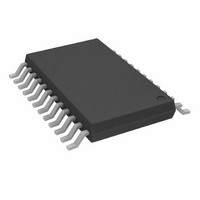ADF7010BRU Analog Devices Inc, ADF7010BRU Datasheet - Page 15

ADF7010BRU
Manufacturer Part Number
ADF7010BRU
Description
IC TX ASK/FSK/GFSK HP 24-TSSOP
Manufacturer
Analog Devices Inc
Datasheet
1.ADF7010BRUZ-REEL7.pdf
(20 pages)
Specifications of ADF7010BRU
Rohs Status
RoHS non-compliant
Frequency
902MHz ~ 928MHz
Applications
Data Transfer, RKE, Remote Control/Security Systems
Modulation Or Protocol
ASK, FSK, GFSK
Data Rate - Maximum
76.8 kbps
Power - Output
-16dBm ~ 12dBm
Current - Transmitting
40mA
Data Interface
PCB, Surface Mount
Antenna Connector
PCB, Surface Mount
Voltage - Supply
2.3 V ~ 3.6 V
Operating Temperature
-40°C ~ 85°C
Package / Case
24-TSSOP
Operating Temperature (min)
-40C
Operating Temperature (max)
85C
Operating Temperature Classification
Industrial
Product Depth (mm)
4.4mm
Operating Supply Voltage (min)
2.3V
Operating Supply Voltage (typ)
3.3V
Operating Supply Voltage (max)
3.6V
Features
-
Memory Size
-
Lead Free Status / Rohs Status
Not Compliant
Available stocks
Company
Part Number
Manufacturer
Quantity
Price
Part Number:
ADF7010BRUZ
Manufacturer:
ADI/亚德诺
Quantity:
20 000
CIRCUIT DESCRIPTION
REFERENCE INPUT SECTION
The on-board crystal oscillator circuitry (Figure 2), allows the
use of an inexpensive quartz crystal as the PLL reference. The
oscillator circuit is enabled by setting XOE low. It is enabled
by default on power-up and is disabled by bringing CE low.
Two parallel resonant capacitors are required for oscillation at
the correct frequency; the value of these is dependent on the
crystal specification. Errors in the crystal can be corrected using
the Error Correction register within the R Register. A single-
ended reference (TCXO, CXO) may be used. The CMOS
levels should be applied to OSC2, with XOE set high.
CLK
The CLK
oscillator section above and supplies a divided down 50:50
mark-space signal to the CLK
is available. This divide is set by the 4 MSBs in the R register.
On power-up, the CLK
The output buffer to CLK
the function register high. On power-up, this bit is set high. The
output buffer can drive up to a 20 pF load with a 10% rise time at
4.8 MHz. Faster edges can result in some spurious feedthrough
to the output. A small series resistor (50 W) can be used to slow
the clock edges to reduce these spurs at F
R COUNTER
The 4-bit R Counter divides the reference input frequency by an
integer from 1 to 15. The divided down signal is presented as the
reference clock to the phase frequency detector (PFD). The divide
ratio is set in the R register. Maximizing the PFD frequency
reduces the N-value. This reduces the noise multiplied at a rate
of 20 log(N) to the output, as well as reducing occurrences of
spurious components. The R register defaults to R = 1 on power-up.
REV. 0
10pF
10pF
OSC1
OUT
Figure 2. Oscillator Circuit on the ADF7010
DIVIDER AND BUFFER
OSC2
OSC1
OUT
DIVIDER
1 TO 15
circuit takes the reference clock signal from the
500k
Figure 3. CLK
OUT
XTAL OSCILLATOR
DIVIDE
100k
BY 2
OUT
DISABLED
defaults to divide by 16.
OUT
is enabled by setting Bit DB4 in
pin. An even divide from 2 to 30
OUT
SW1
DV
NC
DD
Stage
CLK
ENABLE BIT
.
100k
CLK
CLK
TO R COUNTER, AND
CLOCK OUT DIVIDE
OUT
OUT
BUFFER
–15–
PRESCALER, PHASE FREQUENCY DETECTOR (PFD),
AND CHARGE PUMP
The dual-modulus prescaler (P/P + 1) divides the RF signal
from the VCO to a lower frequency that is manageable by the
CMOS counters.
The PFD takes inputs from the R Counter and the N Counter
(N = Int + Fraction) and produces an output proportional to the
phase and frequency difference between them. Figure 4 is a
simplified schematic.
The PFD includes a delay element that sets the width of the
antibacklash pulse. The typical value for this in the ADF7010 is
3 ns. This pulse ensures that there is no dead zone in the PFD
transfer function and minimizes phase noise and reference spurs.
MUXOUT AND LOCK DETECT
The MUXOUT pin allows the user to access various internal
points in the ADF7010. The state of MUXOUT is controlled by
Bits M1 to M4 in the function register.
REGULATOR READY
This is the default setting on MUXOUT after the transmitter has
been powered up. The power-up time of the regulator is typically
50 ms. Since the serial interface is powered from the regulator,
it is necessary for the regulator to be at its nominal voltage
before the ADF7010 can be programmed. The status of the regu-
lator can be monitored at MUXOUT. Once the REGULATOR
READY signal on MUXOUT is high, programming of the
ADF7010 may begin.
CP OUTPUT
R DIVIDER
N DIVIDER
R DIVIDER
N DIVIDER
HI
HI
D1
D2
Figure 4. PFD Stage
CLR1
CLR2
U1
U2
Q1
Q2
UP
DOWN
U3
ADF7010
CPGND
V
P
CHARGE
PUMP
CP













